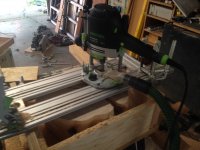squall_line
Member
I know this isn't the first time this topic has been posted or discussed, but it's been stuck in my head a lot lately, and then came up again because WP sent out a sale e-mail for this month.
I have over two dozen slabs of Ash and Maple that will eventually be done drying and come home to be turned into something (or, likely, many things). The slabs are all anywhere from 18" - 24" wide, and cut around 8/4 or so. Perhaps a dozen or so are live edge, the rest are cut on all 4 sides. I think the 5/4 slabs are all live edge, and there are another dozen or so of those as well.
For any of the slabs that I intend to use as table tops or other large-surface tops, I have no desire to cut them in half to flatten them and then stitch them back together again. I've been vacillating on building a slab flattening mill vs. buying one.
Most of the DIY options I see on Youtube and other places have zero dust extraction, and very limited depth adjustment. I realize that dust extraction in this realm is not going to be anywhere near perfect, but just watching some of the videos online of home-brewed solutions without any extraction at all makes me sneeze and my eyes water.
The Woodpecker mill ticks a lot of boxes in what I'm looking to make/use: depth adjustment on the router mount, dust collection ports, dust-trapping skirt, wide capacity, extendable length.
Has anyone built a mill with similar features to the Woodpecker mill? How did it price out in the end?
It seems that linear bearings aren't that hard to come by, and not terribly expensive, but the 8020 rails seems to be where a lot of the cost starts coming into play.
Since none of the slabs are over the weight limit of the STM (I was able to carry them by myself [not ver far, mind you] when they were still wet). I have visions in my head of a mill that would fit on my STM1800 and store away somewhat unobtrusively when not in use. I haven't figured out how to take advantage of the "tilt-to-load" feature of the STM, but it seems that it would make slab loading easier if it was possible to find a way.
That said, I may also start looking around to see if there is anyone local who can flatten slabs for me until I decide whether or not I'm a slab sort of woodworker. It could be that I get through two of these things and decide to just sell off all of the lumber. I'm not sure I need to spend the money and time on a rig if this isn't going to be my bread-n-butter.
I welcome thoughts and discussion, or just merge this into an existing thread if there's too much crossover.
I have over two dozen slabs of Ash and Maple that will eventually be done drying and come home to be turned into something (or, likely, many things). The slabs are all anywhere from 18" - 24" wide, and cut around 8/4 or so. Perhaps a dozen or so are live edge, the rest are cut on all 4 sides. I think the 5/4 slabs are all live edge, and there are another dozen or so of those as well.
For any of the slabs that I intend to use as table tops or other large-surface tops, I have no desire to cut them in half to flatten them and then stitch them back together again. I've been vacillating on building a slab flattening mill vs. buying one.
Most of the DIY options I see on Youtube and other places have zero dust extraction, and very limited depth adjustment. I realize that dust extraction in this realm is not going to be anywhere near perfect, but just watching some of the videos online of home-brewed solutions without any extraction at all makes me sneeze and my eyes water.
The Woodpecker mill ticks a lot of boxes in what I'm looking to make/use: depth adjustment on the router mount, dust collection ports, dust-trapping skirt, wide capacity, extendable length.
Has anyone built a mill with similar features to the Woodpecker mill? How did it price out in the end?
It seems that linear bearings aren't that hard to come by, and not terribly expensive, but the 8020 rails seems to be where a lot of the cost starts coming into play.
Since none of the slabs are over the weight limit of the STM (I was able to carry them by myself [not ver far, mind you] when they were still wet). I have visions in my head of a mill that would fit on my STM1800 and store away somewhat unobtrusively when not in use. I haven't figured out how to take advantage of the "tilt-to-load" feature of the STM, but it seems that it would make slab loading easier if it was possible to find a way.
That said, I may also start looking around to see if there is anyone local who can flatten slabs for me until I decide whether or not I'm a slab sort of woodworker. It could be that I get through two of these things and decide to just sell off all of the lumber. I'm not sure I need to spend the money and time on a rig if this isn't going to be my bread-n-butter.
I welcome thoughts and discussion, or just merge this into an existing thread if there's too much crossover.

